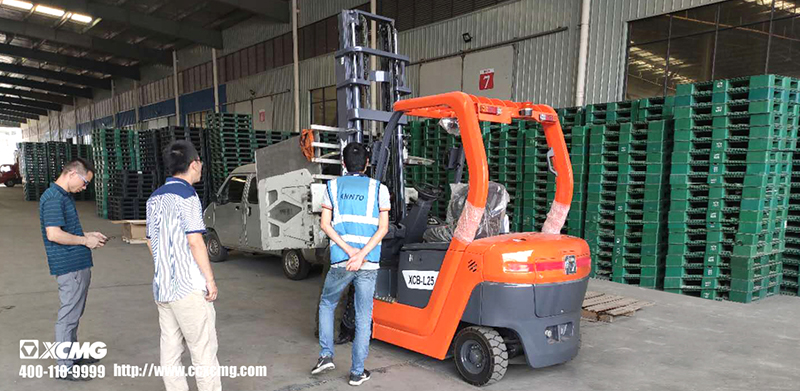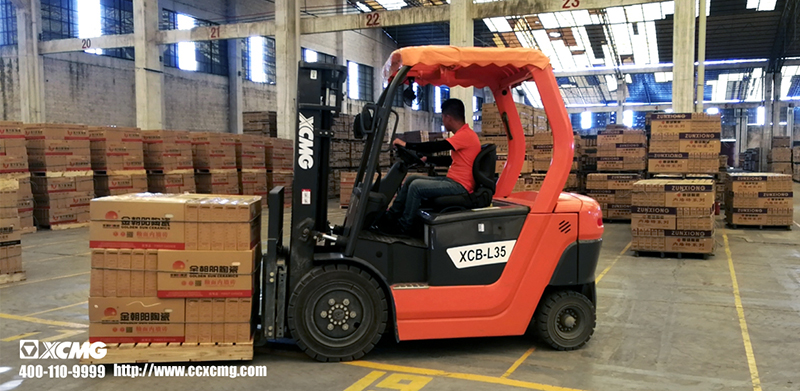
Xugong XCB-D/XCB-DT series internal combustion counterweight forklift is relying on Xugong's own core technology and parts, practicing the gold standard of "technology leadership, use not destroyed", to create a strong cost-effective internal combustion counterweight forklift products.
Main system introduction:
1. Power systemAdopt direct injection combustion system, optimize combustion chamber structure, good starting, low fuel consumption, large torque reserve, strong power; Fuel system adopts electric control distribution pump and high pressure common rail, stable idle speed, low noise, emission to meet the national III emission requirements; The machine has high reliability and durability.
2. Drive systemThe transmission system transmits the power emitted by the engine to the driving wheels and working mechanism to make the forklift drive and work. That is, by slowing down and increasing torque, changing speed and changing rotation, engaging or separating power and changing the direction of power transmission, the power unit can adapt to the driving and operation needs of forklift trucks. The transmission system consists of clutch, transmission and drive axle.
(1) Hydraulic transmission forklift is equipped with torque converter and power shift gearbox, with the following advantages:
a) The micro-valve can enable the forklift truck to operate at low or high engine speed;
b) The hydraulic clutch is equipped with a number of specially treated paper friction plates and steel plates to improve its wear resistance;
c) The one-way overrunning clutch installed in the torque converter improves the power transmission efficiency;
d) There is a better filter in the oil circuit of the torque converter, which improves the life of the torque converter;
(2) Transmission:
Transmission is composed of variable speed transmission structure and variable speed control mechanism, the main function of variable speed transmission mechanism is to change the torque, speed and rotation direction; The main function of the control mechanism is to control the transmission mechanism to realize the change of transmission ratio.
Function of transmission :
a) Expand the range of driving wheel torque and speed to adapt to frequently changing driving conditions, so that the engine works under better working conditions.
b) On the premise that the direction of engine rotation is unchanged, the vehicle is driven in reverse.
c) Interrupt the power transmission to make the engine start, idle and glide.
(3) Drive axle
The function of the drive axle is to transmit the power from the transmission output shaft or the universal transmission device to the drive wheel, achieve a reduction in speed to increase torque, change the direction of torque, achieve differential speed, ensure the pure rolling of the wheel, and carry the load. It consists of a main reducer, a differential, a half shaft and a drive axle housing.
3. Steering system
The steering system is mainly composed of a steering wheel, steering bracket, direction tube, connecting flange and steering gear. The steering wheel is connected through the steering column, connecting flange and steering gear, and the steering column can be tilted forward and back to adjust to the appropriate position, so that the driver has a comfortable driving position.
Load sensing full hydraulic steering system loop is equipped with priority valve, in any working conditions can ensure the priority to its flow distribution, to ensure sufficient oil supply, steering gear is placed in the middle of only a small flow through the steering gear, has a good energy saving effect.
The steering axle consists of a steering axle body, a steering cylinder, a connecting rod, a steering knuckle, and a steering wheel. The pressure oil drives the steering knuckle steering through the cylinder piston rod and connecting rod to make the steering wheel deflect, so as to realize the steering. The steering bridge is connected by a buffer seat.
4. Brake system
The braking system is a front two-wheel brake, consisting of a master brake pump, a brake and a brake pedal. The braking power source can be divided into dynamic braking and ordinary braking. The power of dynamic braking comes from the high pressure oil produced by the gear pump, and the power of ordinary braking comes from the driver's foot.
5. Hydraulic system
The hydraulic system is mainly composed of five parts: power mechanism, actuator, control mechanism, auxiliary device and transmission medium. The main components include: gear pump, multi-way valve, multi-way valve control, lifting cylinder tilt cylinder and oil tank composition.
6. Frame system
Modular design, all structural parts by large CNC laser cutting processing, forming parts using CNC bending machine and hydraulic press die molding; The machined parts adopt large CNC machining center, and the machining accuracy meets the design requirements of the whole machine.
7. Roof guard system
Integral welded top protection frame. The connection with the frame assembly is connected with shock absorbing pad, which reduces the engine idling speed and the resonance caused by the whole machine operation, and improves the operator comfort.




Mr. Zuo:
+86 138-2923-0091tel:
+86 0769-85891080Mail:
heli.2008@vip.163.comaddress:
No. 114 West No. 114, Houjie Avenue, Houjie Town, Dongguan City, Guangdong Province (Xugong Forklift)about
-introduce -application -honor -company -connectproduct
-Electric counterweight forklift truck -Internal combustion counterweight forklift truck -Electric pallet lift truck -Electric pallet stacking forklift -Moreapplication
-Material flow -Stash -aerodrome -Morenews
-dynamic -Information -question


Mobile website
No public
Applets
Copyright © 2023 2023 Dongguan Hengtong forklift Equipment Co., Ltd. All rights reserved 【Backstage】